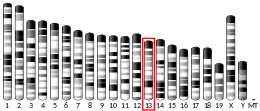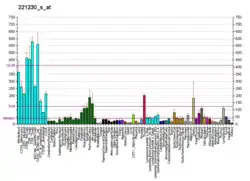AT-rich interactive domain-containing protein 4B is a protein that in humans is encoded by the ARID4B gene.[5][6]
Function
This gene encodes a protein with sequence similarity to retinoblastoma-binding protein-1. The encoded protein is a subunit of the histone deacetylase-dependent SIN3A transcriptional corepressor complex, which functions in diverse cellular processes including proliferation, differentiation, apoptosis, oncogenesis, and cell fate determination. The gene product is recognized by IgG antibody isolated from a breast cancer patient and appears to be a molecular marker associated with a broad range of human malignancies. Alternate transcriptional splice variants encoding different isoforms have been characterized.[6]
References
- 1 2 3 GRCh38: Ensembl release 89: ENSG00000054267 - Ensembl, May 2017
- 1 2 3 GRCm38: Ensembl release 89: ENSMUSG00000039219 - Ensembl, May 2017
- ↑ "Human PubMed Reference:". National Center for Biotechnology Information, U.S. National Library of Medicine.
- ↑ "Mouse PubMed Reference:". National Center for Biotechnology Information, U.S. National Library of Medicine.
- ↑ Cao J, Gao T, Stanbridge EJ, Irie R (Aug 2001). "RBP1L1, a retinoblastoma-binding protein-related gene encoding an antigenic epitope abundantly expressed in human carcinomas and normal testis". J Natl Cancer Inst. 93 (15): 1159–65. doi:10.1093/jnci/93.15.1159. PMID 11481388.
- 1 2 "Entrez Gene: ARID4B AT rich interactive domain 4B (RBP1-like)".
External links
- Human ARID4B genome location and ARID4B gene details page in the UCSC Genome Browser.
Further reading
- Andersen JS, Lyon CE, Fox AH, Leung AK, Lam YW, Steen H, Mann M, Lamond AI (2002). "Directed proteomic analysis of the human nucleolus". Curr. Biol. 12 (1): 1–11. doi:10.1016/S0960-9822(01)00650-9. PMID 11790298. S2CID 14132033.
- Bommel H, Xie G, Rossoll W, Wiese S, Jablonka S, Boehm T, Sendtner M (2003). "Missense mutation in the tubulin-specific chaperone E (Tbce) gene in the mouse mutant progressive motor neuronopathy, a model of human motoneuron disease". J. Cell Biol. 159 (4): 563–9. doi:10.1083/jcb.200208001. PMC 2173089. PMID 12446740.
- Fleischer TC, Yun UJ, Ayer DE (2003). "Identification and characterization of three new components of the mSin3A corepressor complex". Mol. Cell. Biol. 23 (10): 3456–67. doi:10.1128/MCB.23.10.3456-3467.2003. PMC 164750. PMID 12724404.
- Cui D, Jin G, Gao T, Sun T, Tian F, Estrada GG, Gao H, Sarai A (2004). "Characterization of BRCAA1 and its novel antigen epitope identification". Cancer Epidemiol. Biomarkers Prev. 13 (7): 1136–45. doi:10.1158/1055-9965.1136.13.7. PMID 15247124. S2CID 28408982.
- Beausoleil SA, Jedrychowski M, Schwartz D, Elias JE, Villén J, Li J, Cohn MA, Cantley LC, Gygi SP (2004). "Large-scale characterization of HeLa cell nuclear phosphoproteins". Proc. Natl. Acad. Sci. U.S.A. 101 (33): 12130–5. Bibcode:2004PNAS..10112130B. doi:10.1073/pnas.0404720101. PMC 514446. PMID 15302935.
- Olsen JV, Blagoev B, Gnad F, Macek B, Kumar C, Mortensen P, Mann M (2006). "Global, in vivo, and site-specific phosphorylation dynamics in signaling networks". Cell. 127 (3): 635–48. doi:10.1016/j.cell.2006.09.026. PMID 17081983. S2CID 7827573.
This article is issued from Wikipedia. The text is licensed under Creative Commons - Attribution - Sharealike. Additional terms may apply for the media files.




